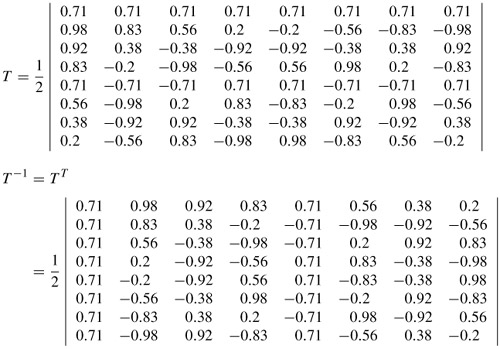3.7 Problems
3.7 Problems
| 1. | In the linear quantiser of Figure 3.4, derive the quantisation characteristics in terms of inputs and outputs, for each of the following conditions:
| | ||||||||||
| 2. | The following eight-bit resolution luminance samples are DPCM encoded with the prediction of previous sample:
If the quantisation is uniform with th = 0 and q = 8,
| | ||||||||||
| 3. | A three-bit nonuniform quantiser is defined as:
If the DPCM data of problem 2 are quantised with this quantiser, find the reconstructed samples and the resulting PSNR value. | | ||||||||||
| 4. | A step function signal with the following eight-bit digitised values:
is DPCM coded with the nonuniform quantiser of problem 3. Plot the reconstructed samples and identify the positions where slope overload and granular noise occur. | | ||||||||||
| 5. | Determine the elements of the 8 × 8 orthonormal forward and inverse DCT transformation matrices. | | ||||||||||
| 6. | Use the DCT matrix of problem 5 to code the following eight pixels: 35; 81; 190; 250; 200; 150; 100; 21
| | ||||||||||
| 7. | The DCT coefficients of problem 6 are linearly quantised with a linear and dead zone quantiser with a step size of th = q = 16. Find the PSNR of the reconstructed pixels. | | ||||||||||
| 8. | Find the PSNR of the reconstructed pixels, if in problem 7 the following coefficients are retained for quantisation and the remaining coefficients are set to zero:
| | ||||||||||
| 9. | A 2 x 2 block of pixels in the current frame is matched against a similar size block in the previous frame, as shown in Figure 3.21, within a search window of ±2 pixels horizontally and ±1 pixel vertically. Find the best matched motion vector of the block, if the distortion criterion is based on:
| | ||||||||||
| 10. | For a maximum motion speed of six pixels/frame:
| | ||||||||||
| 11. | Repeat problem 10 for the following fast search methods:
| | ||||||||||
| 12. | Four symbols of a, b, c and d with probabilities p(a) = 0.2, p(b) = 0.45, p(c) = 0.3 and p(d) = 0.05 are Huffman coded. Derive the Huffman codes for these symbols and compare the average bit rate with that of the entropy. | | ||||||||||
| 13. | In problem 12 a message comprising five symbols cbdad is Huffman coded
What is the decoded message in each case? | | ||||||||||
| 14. | If the intervals of [0.0, 0.2), [0.2, 0.7), [0.7, 0.95) and [0.95, 1) are assigned for arithmetic coding of strings of a, b, c and d respectively, find the lower and upper values of the arithmetic coded string of cbcab. | | ||||||||||
| 15. | With the interval of strings of a, b, c defined in problem 14, suppose the arithmetic decoder receives 0.83955:
| | ||||||||||
| 16. | In arithmetic coding symbols can be decoded using the equation: where R0 is the received number and [Ln, Un) is the interval of the nth symbol in the stream. Use this equation to decode the symbols in problem 15. | | ||||||||||
| 17. | Find the binary arithmetic coding of string cbcab of problem 14. | | ||||||||||
| 18. | Decimal numbers can be represented in binary form by their expansions in powers of 2-1. Derive the first 11 binary digits of the decimal number 0.83955. Compare your results with that of problem 17. | | ||||||||||
| 19. | The binary digits of the arithmetic coded string cbcab are corrupted at the:
Decode the first five symbols of the string in each case. | |
Answers
| 1. |
| ||||||||||||||||||||
| 2. | 12 16 28 240 196 32 PSNR = 43.4 dB | ||||||||||||||||||||
| 3. | 6 12 27 77 127 77 PSNR = 10.7 dB | ||||||||||||||||||||
| 4. | 15 21 19 21 19 69 119 169 219 234 232 230 232 230 | ||||||||||||||||||||
| 5. |
| ||||||||||||||||||||
| 6. |
| ||||||||||||||||||||
| 7. |
| ||||||||||||||||||||
| 8. |
| ||||||||||||||||||||
| 9. |
| ||||||||||||||||||||
| 10. |
| ||||||||||||||||||||
| 11. |
| ||||||||||||||||||||
| 12. |
| ||||||||||||||||||||
| 13. |
| ||||||||||||||||||||
| 14. | lower value = 0.83875, upper value = 0.841875 | ||||||||||||||||||||
| 15. |
| ||||||||||||||||||||
| 16. | the same as 15 | ||||||||||||||||||||
| 17. | 11010110111 | ||||||||||||||||||||
| 18. | the same as 17 | ||||||||||||||||||||
| 19. |
|
EAN: 2147483647
Pages: 148

